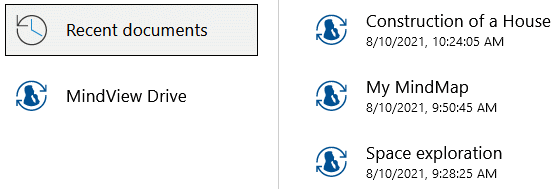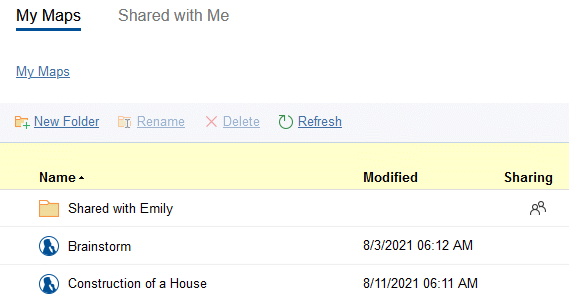 From
the Backstage view, choose New
and then choose the map layout you want.
From
the Backstage view, choose New
and then choose the map layout you want.From the Backstage view, you can create mind maps, and you can open mind maps created by you or shared with you by another user.
 From
the Backstage view, choose New
and then choose the map layout you want.
From
the Backstage view, choose New
and then choose the map layout you want.

The new mind map is opened in the map workspace, ready for editing. It contains a root representing the central idea or theme of the mind map; you can edit the root label as needed by clicking it. The next step is to insert branches. For more information, see "Inserting branches".
![]() You can select a different layout for
your mind map later. For more information, see "Designing
a mind map".
You can select a different layout for
your mind map later. For more information, see "Designing
a mind map".
Notes
 As
you edit your mind map, your changes are saved automatically. You do not
need to manually save your mind map before exiting it.
As
you edit your mind map, your changes are saved automatically. You do not
need to manually save your mind map before exiting it.
 You
can have several mind maps open at the same time. Each additional mind
map is created or opened in a new browser tab or browser window (depending
on how your browser is set up). You do not need to close a mind map before
opening another one. If you want to close a mind map, for example because
you want to delete it, click the MindView
Online logo
You
can have several mind maps open at the same time. Each additional mind
map is created or opened in a new browser tab or browser window (depending
on how your browser is set up). You do not need to close a mind map before
opening another one. If you want to close a mind map, for example because
you want to delete it, click the MindView
Online logo ![]() in the top
left corner of the screen.
in the top
left corner of the screen.
![]() If you are using pop-up blockers or similar software that prevents websites
from opening new windows and tabs, you may need to configure it to allow
MindView Online to open several mind maps. For more information, see the
documentation for the software used.
If you are using pop-up blockers or similar software that prevents websites
from opening new windows and tabs, you may need to configure it to allow
MindView Online to open several mind maps. For more information, see the
documentation for the software used.
 Just
as other users can share their mind maps with you, you can share your
mind maps with other users. If the owner of a shared mind map gives other
users Write access to the mind map, they can edit the mind map simultaneously.
All changes introduced by other users are saved and shown automatically.
For more information, see "Simultaneous
multi-user editing" under "Sharing
files and folders".
Just
as other users can share their mind maps with you, you can share your
mind maps with other users. If the owner of a shared mind map gives other
users Write access to the mind map, they can edit the mind map simultaneously.
All changes introduced by other users are saved and shown automatically.
For more information, see "Simultaneous
multi-user editing" under "Sharing
files and folders".
 From
the Backstage view, choose New
and then choose the template you want to use under New
Map from Template in the main window.
From
the Backstage view, choose New
and then choose the template you want to use under New
Map from Template in the main window.
The templates are organized in folders, making it easy to find a template that suits your purpose.

The new mind map is opened in the map workspace, ready for editing. By default, it contains content from the template used, but you can edit it as desired.
 From
the Backstage view, choose Open.
From
the Backstage view, choose Open.

 Do
one of the following:
Do
one of the following:
 Choose
a map from the list of recent documents to open it.
Choose
a map from the list of recent documents to open it.
 Click
MindView Drive
Click
MindView Drive ![]() ,
and locate and open a map.
,
and locate and open a map.

The My Maps tab contains maps created by you, and the Shared With Me tab contains maps shared with you by other users, if any.
![]() Like the Manage
Files view, this view allows you to create, rename and delete subfolders.
For a description of these options, see the description of the Manage
Files view in "Managing
files and folders".
Like the Manage
Files view, this view allows you to create, rename and delete subfolders.
For a description of these options, see the description of the Manage
Files view in "Managing
files and folders".
The mind map is opened in the map workspace, ready for editing. If you have Read only access to the mind map (because the user who created it and shared it with you has not given you Read/Write access), you cannot edit it. However, you can create a duplicate of the mind map and edit this file instead. For more information, see "Options for individual folders and files" under "Managing files and folders".